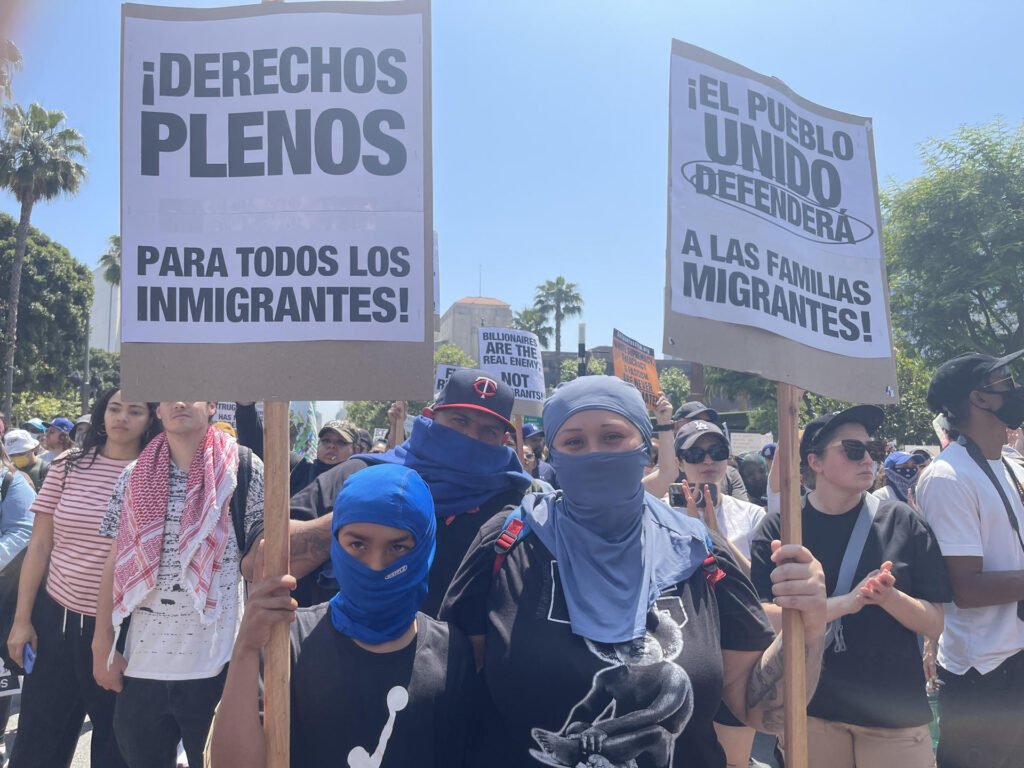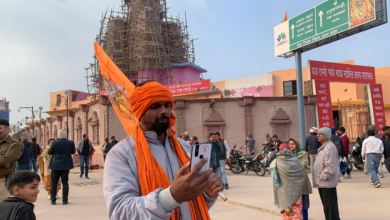Latin American Voices Defying Immigration Hunt Still Flooding L.A.

Helicopters rumble above Los Angeles while National Guard troops patrol downtown, but Latin American migrants and their allies refuse to disappear. As federal agents widen a month-long dragnet, neighborhoods answer with pot-banging defiance and a chorus: “Aquí seguimos.”
Before Sunrise, The Knock Arrives
At 4:37 A.M., the stillness of Whittier’s main square shatters. Unmarked SUVs slide into the City Hall lot; men in navy jackets hustle out, radios crackling, wrists filled with zip-ties. Maria López, cleaning offices nearby, records through a cracked window: one by one, cooks, carpenters, and landscapers—people she knows by first name—are marched toward dark-tinted vans. No Miranda warning, no explanation. “The silence,” she later tells EFE, “was louder than any siren.”
By breakfast, the rumor mill spins faster than traffic on the 5. A leaked memo—confirmed by Congresswoman Nanette Barragán to CNN—says ICE teams will scour Los Angeles County for thirty straight days, backed by Customs and Border Protection and two thousand National Guard soldiers flown in under an emergency order from President Donald Trump. The blunt directive yanks Californians back to the hammer-fist raids of 2018, but on a scale unseen even then.
The county is home to an estimated one million people without status, many of whom are woven into every industry, from strawberries to film sets. Monday’s operation phase differs from Friday’s factory warrants: agents claim the sidewalk as jurisdiction this time. Outside a Home Depot in Commerce, day-labor organizer Luis Hernández livestreams three men being questioned over coffee cups. “They’re asking for papers like we’re in the seventies,” he mutters, the camera trembling. His feed goes viral before noon; it has reached a million screens by dusk.
Phones Become Sirens; Kitchens Become Headquarters
Suppose the raids unfold with military precision; the resistance forms like water, finding cracks. Within hours, WhatsApp chains light up in Spanish, Mixtec, K’iche’ and Zapotec. Volunteer drivers circle garment districts blaring a single instruction: “¡No firmen nada!”—sign nothing. In Boyle Heights, teenage coders post an interactive map of detention sightings updated every five minutes. When ICE vehicles appear outside a pallet yard, neighbors swing open back-house gates to funnel workers through alleys until the vans leave empty.
The immediacy astonishes even veteran activists. Unión del Barrio once relied on fax machines and bus fare; now, a shaky cell phone clip triggers a flash protest in minutes. Pots and pans clang on Florence Avenue as parents—some documented, many not—keep children home from school. On Instagram, abuelitas demonstrates how to hide cash and medication inside cereal boxes in case the next knock is at their own door.
Mothers push strollers toward City Hall by mid-afternoon, waving hand-painted flags: emerald Mexican tricolors beside Guatemalan sky blue, Salvadoran white, and Haitian red-and-blue. One banner sums up the mood: “I cook your food, clean your office, and love this country—why deport me?” Reporters note that LAPD officers retreat to the building’s shade as the crowd swells, uneasy about enforcing federal warrants that city policy refuses to recognize.

Capitol Showdown: Sovereignty Versus Spectacle
Governor Gavin Newsom is in Sacramento when helicopters begin thumping over downtown Los Angeles. He posts a short but combustible message: “California did not request troops. Washington is hijacking local peace officers to project fear.” He hints at withholding billions in state-collected federal taxes if the deployment continues, an idea cheered on Twitter and dissected by constitutional scholars before the sun sets.
President Trump responds with characteristic flame. “Anarchists testing my patience—National Guard will restore order,” he tweets, adding a ban on masks at protests. The edict does the opposite of deterrence: by evening, thousands converge on Pershing Square wearing colorful bandanas emblazoned with the words “Try and stop me.”
Los Angeles Mayor Karen Bass appears on local television promising to uphold sanctuary ordinances while begging residents to avoid confrontation. Yet she cannot ignore the optics: Humvees blocking the federal detention center’s driveway, camouflaged soldiers cradling rifles where commuters typically queue for buses. Analysts on Univision call it the sharpest test of California-Washington relations since the Proposition 187 battles of the 1990s.
Tear Gas On The 101, Lawsuits in The Wings
Near sunset, an impromptu march spills onto the 101 Freeway. Families in minivans watch as protesters unfurl a banner across all lanes: “We build America—No Deportations.” State troopers deploy tear gas, and clouds drift over stalled traffic. A cell phone video shows a little girl clutching a Pikachu backpack, tears streaking her cheeks as her mother presses a soaked T-shirt to her eyes. The clip airs on nightly news, eclipsing presidential sound bites.
California Attorney General Rob Bonta filed an emergency suit hours later, accusing the administration of violating the Posse Comitatus Act—the ban on using soldiers as domestic police. Civil rights lawyers stack affidavits from residents exposed to gas or denied information about detained relatives. Unions hold evening webinars preparing members for work stoppages if ICE begins factory raids at scale.
Volunteers distribute tamales, diapers, and prepaid phones inside makeshift sanctuaries—church basements, backyard casitas, and a converted boxing gym. School districts text families in three languages: campuses remain safe; ICE needs a signed judicial warrant to enter. Absentee rates spike anyway. “How can I send my kids when soldiers stand at the freeway exit?” asked daycare worker Rosa Martinez, whom EFE interviewed.
She is not alone in fear, yet defiance grows louder. On Wednesday, a mariachi band positions itself before the ICE field office, trumpets blasting “La Negra” while activists chant, “Aquí estamos, y no nos vamos.” National Guard colonels watch from behind metal fencing, unsure whether to interpret the music as provocation or culture on parade.
What Comes After the Sirens Fade
Federal planners talk of a 30-day window, but history suggests raids forge solidarities that last far longer. The 2006 “Gran Marcha” drew half a million Angelenos after a less aggressive push; Proposition 187’s crackdown two decades earlier helped turn California deep blue. Political strategists whisper that televised images of soldiers detaining gardeners could swing suburban districts against the party in power.
For migrants, the calculations are more immediate: hide in place, risk the roadblock for groceries, and decide whether to trust a school bus. Beatriz Feliz, a naturalized citizen whose mother once crossed without papers, brings her nine-year-old to every march. “He must see how we fight for our neighbors,” she tells EFE, her voice hoarse after hours of leading chants.
No one knows if ICE will exhaust its list before lawyers tie knots in federal court or if the Guard will withdraw quietly at Newsom’s next press conference. What is clear is that the first volley already redrew lines between state and federal power, between fear and solidarity. Helicopters still circle, but so do volunteers passing out breakfast burritos to families afraid of leaving home at dawn.
Also Read: Bolivia’s Declining Fertility Rate Mirrors Women’s Expanding Opportunities
On Whittier’s asphalt, the dark vans may roll again tomorrow, and door hinges will creak at sunrise. If they do, loudspeakers will answer, phone cameras will click, pots will clang, and a bilingual chorus will rise over engines: “Aquí seguimos. No nos van a borrar.” We are still here. They will not erase us.





